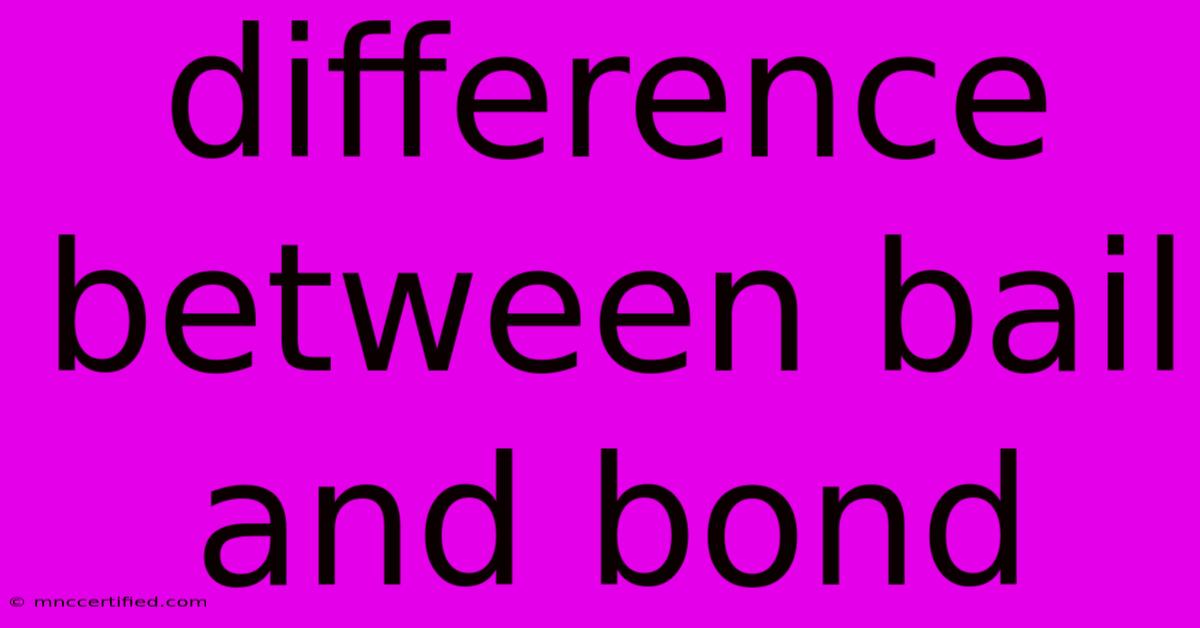Difference Between Bail And Bond

Table of Contents
Bail vs. Bond: Understanding the Key Differences
When facing arrest, understanding the legal terminology surrounding your release can be crucial. Two terms often confused are "bail" and "bond." While they both relate to securing pretrial release, there are significant differences. This article will clarify the distinction between bail and bond, helping you navigate this complex legal landscape.
What is Bail?
Bail is a sum of money or property that an arrested individual deposits with the court to guarantee their appearance at future court hearings. It's a promise to the court: show up for your hearings, and you get your money (or property) back. Fail to appear, and the court keeps the bail as a penalty. The amount of bail is set by a judge, taking into account factors like the severity of the crime, the defendant's criminal history, and the risk of flight.
Key Characteristics of Bail:
- Set by a judge: The judge determines the bail amount based on specific criteria.
- Directly to the court: The bail money is paid directly to the court.
- Refundable: Upon fulfilling all court obligations, the bail is typically refunded.
- Can be cash or property: Depending on court rules, bail can be paid in cash, or with approved property as collateral.
What is a Bond?
A bond is a financial guarantee provided by a bail bondsman (or surety). Instead of paying the full bail amount directly to the court, the accused pays a percentage of the bail amount (typically 10-15%) to the bondsman. The bondsman then posts the full bail amount to the court, guaranteeing the defendant's appearance. If the defendant fails to appear, the bondsman is responsible for paying the full bail amount to the court.
Key Characteristics of a Bond:
- Secured through a bail bondsman: A third party, the bondsman, acts as a guarantor.
- Percentage payment: You only pay a percentage of the bail amount to the bondsman.
- Non-refundable premium: The fee paid to the bondsman is typically non-refundable, regardless of the outcome.
- Risk for the bondsman: The bondsman assumes the risk of the defendant's failure to appear.
Bail vs. Bond: A Comparison Table
| Feature | Bail | Bond |
|---|---|---|
| Payment | Directly to the court | To a bail bondsman |
| Amount Paid | Full bail amount | Percentage of bail amount (premium) |
| Refundable? | Usually, yes | Usually, no (premium is non-refundable) |
| Guarantor | Defendant | Bail bondsman |
| Risk | Defendant loses bail if they flee | Bail bondsman loses bond amount if defendant flees |
| Accessibility | Available to those who can afford it | Available to those who cannot afford full bail |
Choosing Between Bail and Bond: Which is Right for You?
The choice between bail and bond often depends on financial resources. If you have the full bail amount, paying it directly to the court is the more cost-effective option. However, if you cannot afford the full bail, a bond is a viable alternative. Remember, using a bond involves paying a non-refundable fee, so carefully weigh the costs and benefits.
Seeking Legal Advice
This information is for educational purposes only and should not be considered legal advice. The specific requirements and procedures surrounding bail and bond can vary significantly by jurisdiction. It’s crucial to consult with a qualified legal professional for advice tailored to your specific situation. They can help you understand your rights and navigate the complexities of the bail and bond system. Remember, understanding your options is key to ensuring a fair legal process.

Thank you for visiting our website wich cover about Difference Between Bail And Bond. We hope the information provided has been useful to you. Feel free to contact us if you have any questions or need further assistance. See you next time and dont miss to bookmark.
Featured Posts
-
Steph Houghton Husbands Mnd Battle
Nov 20, 2024
-
Is New Sapience A Good Investment
Nov 20, 2024
-
Linda Mc Mahon Nominated Education Secretary
Nov 20, 2024
-
Altucher Investment Network Login
Nov 20, 2024
-
Matthew Murphy Fisher Investments
Nov 20, 2024